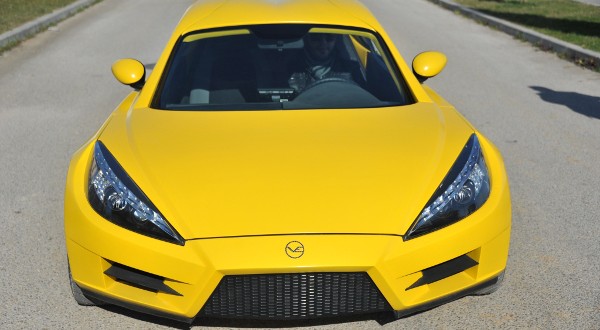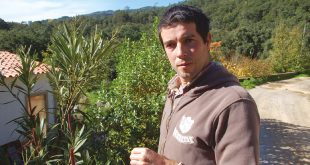It is quiet and quite fast. And let’s be clear from the outset: it does 160 km/h. I swung myself inside and simply drove off, but not before listening to a long list of worries from the anxious patentee. The vehicle only had third party and no comprehensive insurance. I should be sure to drive carefully. It was a disguised prototype and in Monchique the farmers with their tractors were … and so on and so forth. I pulled down my scissor door and it fell into the lock with a solid clunk. Turned the key. Humming quietly, the spaceship started on its way through the orbit of the mountains. João Oliveira, this small, wiry, vehicle-constructor-to-be sat next to me, stricken with fear. A picture of misery because I had told him that I wanted to really put this electric car through its paces. He must have understood that as a threat, because he actually thought I would allow myself to be fobbed off with sitting in the passenger seat. He was very much mistaken. Journalists have to test things properly. And now he’s getting into a sweat beside me. Seatbelts on. We take the road up to the top of Picota. Cornering, right, left, foot hard down on the accelerator, faster, brake and then into the next bend, ascents up to seven hundred metres, really pushing it, and then back down again. On the way downhill, the craft accumulates bonus miles, without fossil fuels, without CO², the battery fills up again. Nothing kerosene-, petrol- or diesel-powered can rival that.
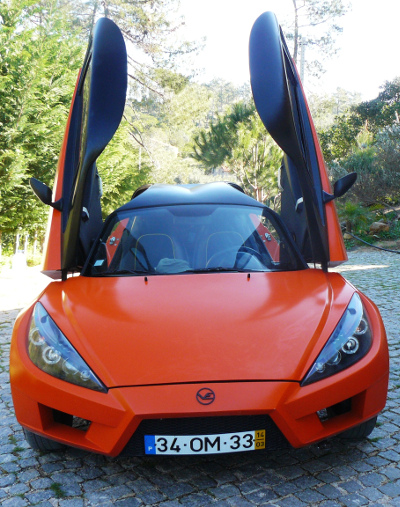 It’s not a Tesla, nor is it a Nissan or BMW or anything else. The spacecraft is called VEECO. All readers should make a note of the name. It’s 8 o’clock on a Sunday morning. For most people, the Feira de Monchique came to a late and rather damp conclusion on the Saturday evening. The streets are deserted. Only the police are standing around bored at the crossroads in the village, offering a standing escort. I had gone to bed early (and dry) and am feeling really fit for test driving Number Two, a nippy, orange car from the House of Oliveira, the two-seater roadster in which the car constructor has already driven 15,000 km. Putting it through its paces: the second Portuguese car to be tried out in practice; it can now go into mass production because it has finally, after two years full of tests, been granted authorization by the IMT for all public roads. The yellow Number One is in the museum of the future factory in Entroncamento, 100 km north of Lisbon. This is where the eight years of work have ended up, and where 1.8 million euros of capital from Lisbon and Brussels have been burned up, sorry, I mean invested. The engineers from ISEL*¹ in Lisbon and ISEP*² in Porto were involved. It was they who put the VEECO on the road, with its streamlined shape like a drop of water, custom-made as a three-wheeler, rear-wheel drive via one fat tyre on a 245 mm wide wheel.
It’s not a Tesla, nor is it a Nissan or BMW or anything else. The spacecraft is called VEECO. All readers should make a note of the name. It’s 8 o’clock on a Sunday morning. For most people, the Feira de Monchique came to a late and rather damp conclusion on the Saturday evening. The streets are deserted. Only the police are standing around bored at the crossroads in the village, offering a standing escort. I had gone to bed early (and dry) and am feeling really fit for test driving Number Two, a nippy, orange car from the House of Oliveira, the two-seater roadster in which the car constructor has already driven 15,000 km. Putting it through its paces: the second Portuguese car to be tried out in practice; it can now go into mass production because it has finally, after two years full of tests, been granted authorization by the IMT for all public roads. The yellow Number One is in the museum of the future factory in Entroncamento, 100 km north of Lisbon. This is where the eight years of work have ended up, and where 1.8 million euros of capital from Lisbon and Brussels have been burned up, sorry, I mean invested. The engineers from ISEL*¹ in Lisbon and ISEP*² in Porto were involved. It was they who put the VEECO on the road, with its streamlined shape like a drop of water, custom-made as a three-wheeler, rear-wheel drive via one fat tyre on a 245 mm wide wheel.
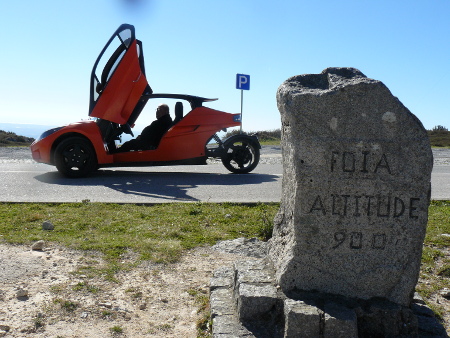 What fantastic cornering! It clings to the road like a plank. Well done, no power steering, rather direct transmission. That’s the way it should be. With the small motor you can drive it as a 16-year-old, rather like a big moped, or go racing in Barcelona with the big motor, with a proper driving licence, needless to say. But first things first: now I have to get up the second mountain, the highest in the south of Portugal, the 900-metre-high Fóia. 360 degree panoramic view in brilliant weather: view of the south-west cape of Europe. The windscreen wipers work, the electric windows too. At nearly 9 o’clock we are greeted by the early risers in brilliant weather. Look, I wonder what that lovely car is… We collect bonus miles again on the descent to Monchique, eight kilometres away. I’ve almost emptied the battery. After two hours of hard driving, there’s only enough juice left in the battery for about ten kilometres. By the time we arrive back in Monchique, the number of kilometres we could still travel has risen to 20: the wonderful recharging of a battery through energy recovery. Two seats, room for two small suitcases or travel bags under the aerodynamic bonnet, and below that the batteries are mounted, whose weight ensures that the roadster holds the road well. The car – one mustn’t forget this or confuse it with anything else – is a toy and not a tractor. You really can’t load it up with half a ton of wood, and it doesn’t chug, dear farmers, it hums. The VEECO RT with the small battery is due to cost around 25,000 euros. The plan is to start building the first limited edition of 50 vehicles this year, by hand. Future buyers now have a choice of four types of battery, 16, 20, 30 or 48 KW/h and a guaranteed range of 160 to 430 kilometres. And that’s what it depends on: range. They say they’re entering into negotiations with Bosch in Stuttgart.
What fantastic cornering! It clings to the road like a plank. Well done, no power steering, rather direct transmission. That’s the way it should be. With the small motor you can drive it as a 16-year-old, rather like a big moped, or go racing in Barcelona with the big motor, with a proper driving licence, needless to say. But first things first: now I have to get up the second mountain, the highest in the south of Portugal, the 900-metre-high Fóia. 360 degree panoramic view in brilliant weather: view of the south-west cape of Europe. The windscreen wipers work, the electric windows too. At nearly 9 o’clock we are greeted by the early risers in brilliant weather. Look, I wonder what that lovely car is… We collect bonus miles again on the descent to Monchique, eight kilometres away. I’ve almost emptied the battery. After two hours of hard driving, there’s only enough juice left in the battery for about ten kilometres. By the time we arrive back in Monchique, the number of kilometres we could still travel has risen to 20: the wonderful recharging of a battery through energy recovery. Two seats, room for two small suitcases or travel bags under the aerodynamic bonnet, and below that the batteries are mounted, whose weight ensures that the roadster holds the road well. The car – one mustn’t forget this or confuse it with anything else – is a toy and not a tractor. You really can’t load it up with half a ton of wood, and it doesn’t chug, dear farmers, it hums. The VEECO RT with the small battery is due to cost around 25,000 euros. The plan is to start building the first limited edition of 50 vehicles this year, by hand. Future buyers now have a choice of four types of battery, 16, 20, 30 or 48 KW/h and a guaranteed range of 160 to 430 kilometres. And that’s what it depends on: range. They say they’re entering into negotiations with Bosch in Stuttgart.
What’s the next step?
After all the technology and excitement, we now come to the heart of the matter, clean mobility and financing. After all, this is not a car magazine that celebrates cars every week. What I wanted to achieve with the test drive has been done. My verdict: the VEECO has become ready to invest in. Of course, there are a few things still to add to the spaceship, airbags and ABS for snow and ice for the northern European market.
But let’s start at home in Portugal. From the point of view of fiscal policy, the VEECO RT is a challenge for Portugal, but financially it represents a unique opportunity to make investments in the steadily growing field of ecological mobility. No one from among the eight million adults with a right to a driving licence should miss the opportunity of a test drive in the VEECO RT. As it burns neither petrol nor diesel and has become very roadworthy, but does not pour any petroleum tax into the state’s coffers, I’m curious to see what kind of support those in power will provide. For example, VAT on the VEECO could be abolished in order to get this environmentally friendly, Portuguese vehicle up and running. It could be exempted from motorway tolls, too, and much more besides.
This government, the Prime Minister and Ministers of the Economy and the Environment could do a lot for the Portuguese VEECO. But they haven’t even discovered the car yet. Perhaps that’s on its way. They could use it to score a few points in Europe and even show Frau Merkel that they were serious about Portugal and the economic miracle. We have got the VEECO and you have your Volkswagen, BMW, Mercedes, Porsche, Audi etc. That sounds rather like: you in Germany may have the watches, but we Portuguese have the time – and the sun and so many other wonderful things.
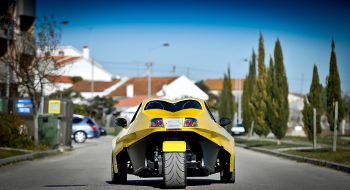 Have any politicians really got the ecological interest to open up the future for this wonderful little spaceship? If people were used to doing things quickly – like in the USA – it would be possible to order the VEECO immediately, like on the commodity futures exchange, by buying a future. Down payment and bet on it being delivered to your doorstep “chave na mão” within 180 days. The government could also get rid of some of its Mercedes, Volvos, BMWs and Audis, and buy the VEECO as a sporty state limousine for the Prime Minister. Of course, Portuguese people should drive Portuguese cars, shouldn’t they? As it is a two-seater, even chauffeurs could join in. The Portuguese Tourist Board should buy it too and expand ECO car sharing in that way. In front of every e-car charging point in the Algarve, a VEECO RT could be parked so that people could delight in the wonderful shape of a streamlined e-car just as they delight in the sun, which normally shines here for 300 days a year. Car rental companies, municipalities, the ICNF etc. The VEECO will be available in almost all sunny colours because the future Portuguese car producer has found an outstanding business partner in Fibrauto SA near Porto. They are building the bodywork and the wings in one piece, as well as the doors and the other bits of panelling. This ensures that spare parts will be available immediately in the event of an accident.
Have any politicians really got the ecological interest to open up the future for this wonderful little spaceship? If people were used to doing things quickly – like in the USA – it would be possible to order the VEECO immediately, like on the commodity futures exchange, by buying a future. Down payment and bet on it being delivered to your doorstep “chave na mão” within 180 days. The government could also get rid of some of its Mercedes, Volvos, BMWs and Audis, and buy the VEECO as a sporty state limousine for the Prime Minister. Of course, Portuguese people should drive Portuguese cars, shouldn’t they? As it is a two-seater, even chauffeurs could join in. The Portuguese Tourist Board should buy it too and expand ECO car sharing in that way. In front of every e-car charging point in the Algarve, a VEECO RT could be parked so that people could delight in the wonderful shape of a streamlined e-car just as they delight in the sun, which normally shines here for 300 days a year. Car rental companies, municipalities, the ICNF etc. The VEECO will be available in almost all sunny colours because the future Portuguese car producer has found an outstanding business partner in Fibrauto SA near Porto. They are building the bodywork and the wings in one piece, as well as the doors and the other bits of panelling. This ensures that spare parts will be available immediately in the event of an accident.
On the subject of sunshine. An independent solar filing station, a charging point with solar panels for your home, was presented by the company FF Solar headquartered in Aljezur at the Feira de Monchique. A lot of people were interested in advice about how e-mobility can be implemented, from theory into practice. First of all, your electric vehicle can be charged with the solar power system, but your house or flat can also be supplied with power. Because while you are out and about in your VEECO RT, solar power is simply connected to the domestic circuit, for your fridge, washing machine etc. With the sun on its side, Portugal can only win.
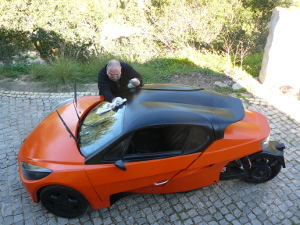 ECO123 asked João Oliveira what his economic plan is for marketing this eco-friendly niche vehicle? To produce a first, limited edition, the vehicle manufacturer would need around 1.5 million euros in start-up capital for purchasing goods, and presented a transparent, five-year business plan. As a confidence-building measure, the VEECO RT will be doing a three-month roadshow through Portugal this summer. So, you can invite it to your home: to Lisbon, Porto, to the Algarve, to the remotest corner of the country. There, interested members of the public can touch, smell, see, hear and taste the VEECO, and also test drive it. People who want to buy one straight away after testing it thoroughly will be able to order one directly, or a bit later via three-month crowdfunding that is taking place from September 2015. With a deposit of about €1,000 everyone can reserve themselves a VEECO. The first preliminary discussions have already taken place.
ECO123 asked João Oliveira what his economic plan is for marketing this eco-friendly niche vehicle? To produce a first, limited edition, the vehicle manufacturer would need around 1.5 million euros in start-up capital for purchasing goods, and presented a transparent, five-year business plan. As a confidence-building measure, the VEECO RT will be doing a three-month roadshow through Portugal this summer. So, you can invite it to your home: to Lisbon, Porto, to the Algarve, to the remotest corner of the country. There, interested members of the public can touch, smell, see, hear and taste the VEECO, and also test drive it. People who want to buy one straight away after testing it thoroughly will be able to order one directly, or a bit later via three-month crowdfunding that is taking place from September 2015. With a deposit of about €1,000 everyone can reserve themselves a VEECO. The first preliminary discussions have already taken place.
With a deposit, the newly founded Veeco – Fabrico de Veículos Electricos e Ecológicos Lda. (share capital €350,000) in Entroncamento guarantees the crowdfunder and future VEECO customer that their electric car will be delivered within 180 days, in their preferred colour, with the electric motor of their choice and the chosen battery size. Green light for an environmentally friendly future: it can start with the first 50 electric cars suitable for everyday use – Made in Portugal.
Zona Industrial do Entroncamento Lote 3 – Casal Marcos Ferreira 2330-210 Entroncamento
Gerente: João Manuel Marques da Silva de Oliveira
joliveira.ve@gmail.com
TM 968 034 638
 Eco123 Revista da Economia e Ecologia
Eco123 Revista da Economia e Ecologia

